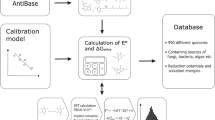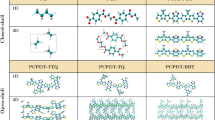Abstract
MOST molecular complexes are essentially of the non-bonding type and their infra-red spectra are quite similar to the superposed spectra of the components1,2. However, the infrared, spectra of some diamine-quinone complexes and azine-quinone complexes have been found to show the pattern of the semiquinone ion instead of the quinone. Such complexes have been characterized as essentially of the dative type. Thus charge transfer molecular complexes may be classified into two groups, namely, the non-bonding type and the dative type, based on their infrared spectra. Using this method of classification, I have pointed out that most of the known complexes having resistivities of 105 ohm cm or less are of the dative type3.
This is a preview of subscription content, access via your institution
Access options
Subscribe to this journal
Receive 51 print issues and online access
$199.00 per year
only $3.90 per issue
Buy this article
- Purchase on Springer Link
- Instant access to full article PDF
Prices may be subject to local taxes which are calculated during checkout
Similar content being viewed by others
References
Kainer, H., and Otting, W., Chem. Ber., 88, 1921 (1955).
Eastman, J. W., Androes, H. M., and Calvin, M., J. Chem. Phys., 36, 1197 (1962).
Matsunaga, Y., J. Chem. Phys., 41, 1609 (1964).
Matsunaga, Y., submitted to J. Chem. Phys.
Kronick, P. L., Scott, H., and Labes, M. M., J. Chem. Phys., 40, 890 (1964).
Labes, M. M., Sehr, R., and Bose, M., J. Chem. Phys., 33, 868 (1960).
Eley, D. D., Inokuchi, H., and Willis, M. R., Disc. Faraday Soc., 28, 54 (1959).
Kronick, P. L., and Labes, M. M., J. Chem. Phys., 35, 2016 (1961).
Ottenberg, A., Brandon, R. L., and Browne, M. E., Nature, 201, 1119 (1964).
Schwarz, M., Davies, H. W., and Dobriansky, B. J., J. Chem. Phys., 40, 3257 (1964).
Author information
Authors and Affiliations
Rights and permissions
About this article
Cite this article
MATSUNAGA, Y. Electrical Resistivities and the Type of Bonding in Some Quinone Complexes. Nature 205, 72–73 (1965). https://doi.org/10.1038/205072a0
Published:
Issue Date:
DOI: https://doi.org/10.1038/205072a0
This article is cited by
Comments
By submitting a comment you agree to abide by our Terms and Community Guidelines. If you find something abusive or that does not comply with our terms or guidelines please flag it as inappropriate.



